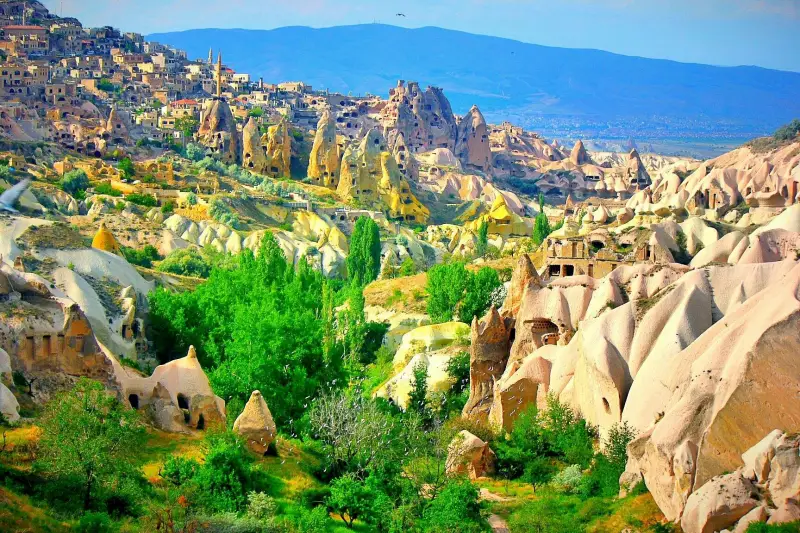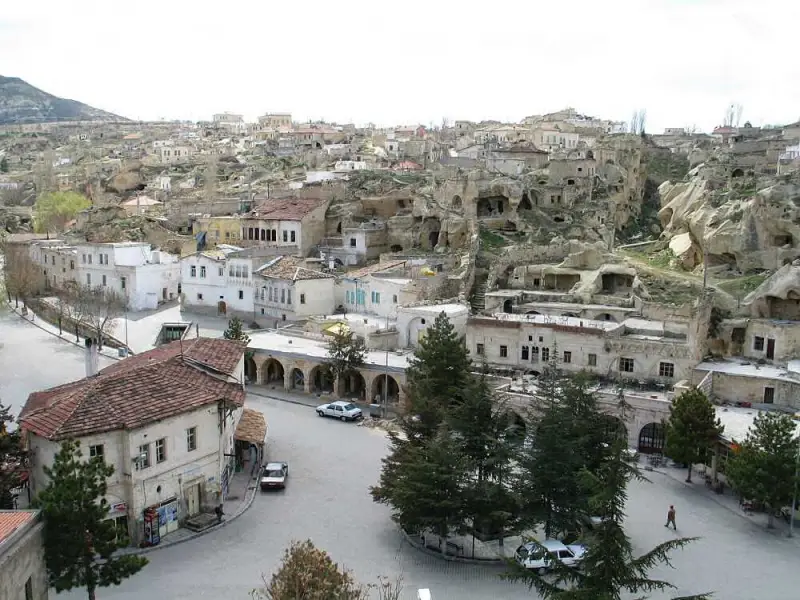Exploring the Mystical Goreme National Park: A Journey Through History
The Goreme Open Air Museum stands as a monumental testament to the rich, spiritual history of Cappadocia, Turkey. Nestled in a scenic valley, this UNESCO World Heritage site offers a unique glimpse into the lives of the early Christian settlers through its fascinating rock-hewn churches, chapels, and monasteries adorned with vibrant frescoes. This blog post delves into the enchanting world of the Goreme Open Air Museum, providing an immersive guide for all who wish to explore this historical gem. What to do in Cappadocia besides hot air balloons?
The Historical Significance of Göreme Open Air Museum

Before venturing into the stone-carved sanctuaries of the Goreme Open Air Museum, it’s essential to grasp the profound historical context that surrounds this iconic site. Acting as a vivid tableau, the museum not only showcases the religious and communal life of early Christians in Cappadocia but also stands as a symbol of resilience and devotion.
Origins and Early History of Goreme Open Air Museum
Dating back to the 4th century, the Goreme Open Air Museum marks the dawn of monastic life in Cappadocia. Early Christian monks, seeking solitude and a closer connection to their faith, carved extensive dwellings and places of worship into the region’s soft volcanic rock. These pioneers of Christianity established a monastic tradition that would influence the region for centuries, making Göreme a focal point of religious scholarship and ascetic practice.
UNESCO Recognition and Preservation

The designation of the Goreme Open Air Museum as a UNESCO World Heritage site in 1984 underscores its immense cultural and historical importance. This prestigious status not only recognizes the museum as a treasure of human creativity and religious devotion but also commits to protecting and preserving its structures and artworks for future generations. The ongoing conservation efforts ensure that the intricate frescoes and unique architectural details continue to convey the spiritual and historical narratives of their creators, providing a window into the Byzantine world that shaped this landscape.
Exploring the Cave Churches in Goreme Open Air Museum

The Goreme Open Air Museum is celebrated for its remarkable ensemble of cave churches, each a gallery of ancient frescoes depicting biblical narratives. These sacred spaces provide a profound spiritual journey and highlight the exceptional artistry of the time, offering a window into the devotional practices and creative expression of early Christians in Cappadocia.
The Dark Church (Karanlık Kilise)
The Dark Church, or Karanlık Kilise, stands out among the Goreme churches for its exceptionally well-preserved frescoes. The minimal natural light exposure over the centuries has helped preserve the vibrant colors and intricate details of the paintings, which cover almost every inch of the interior. Visitors are often struck by the vivid blues and reds, which remain as bright today as they were centuries ago. The frescoes depict scenes from the New Testament, including the crucifixion, descent into hell, and Christ Pantocrator, and offer a profound insight into the theological artistry of the Byzantine era.
The Apple Church (Elmalı Kilise)
The Apple Church, or Elmalı Kilise, earns its name from a distinct red apple depicted in one of the frescoes, symbolizing the fall of man. This church showcases a unique range of iconographies and theological themes, featuring an extensive series of frescoes that narrate the life of Christ from birth to resurrection. Art lovers and historians will find the Apple Church particularly intriguing for its artistic nuances and the way it reflects the evolving Byzantine iconographic styles. The frescoes here not only depict biblical events but also are imbued with symbolic elements that convey deeper spiritual messages, making the Apple Church a captivating stop in the exploration of Göreme’s spiritual heritage.
Unique Frescoes and Iconography

The frescoes within the Goreme Open Air Museum are not just remarkable for their aesthetic beauty but for their ability to convey deep theological and historical narratives. Each stroke and color choice reveals insights into the spiritual and societal values of the time, making these artworks significant beyond their visual appeal.
Symbolism and Themes
The iconography of the Goreme frescoes does much more than adorn the walls; it serves as a profound commentary on spiritual themes central to early Christian theology. These images are laden with symbolism, depicting stories of redemption, divine judgment, and the milestones in the life of Christ. For instance, scenes from the Last Judgement are not just illustrations but serve as moral guides for the faithful, illustrating the path to salvation and the consequences of sin. Such themes resonated strongly with the local community and pilgrims, reflecting their hopes, fears, and devoutness.
Restoration and Conservation Efforts

Preserving these ancient treasures is an ongoing challenge and priority. The delicate nature of the frescoes, combined with their age and the environmental conditions of the region, necessitates meticulous conservation efforts. Advanced restoration techniques and international collaborations have been pivotal in maintaining the vibrancy and detail of these frescoes. Specialists in art restoration and conservation work tirelessly to stabilize the pigments and prevent further deterioration, ensuring that these invaluable insights into Byzantine art and early Christianity can be appreciated by future generations. Through such dedicated efforts, the Göreme Open Air Museum continues to be a vibrant testament to the artistic and spiritual endeavors of the past.
Monastic Life in the Rocks in Goreme Open Air Museum

Exploring the monastic life in the rocks of Goreme offers a unique perspective into the daily lives and spiritual practices of the monks who inhabited these ancient cave complexes. Their commitment to a life of spirituality and community under harsh conditions is a testament to their dedication and resilience.
Living Quarters and Community Layout
The cave complexes of Goreme were ingeniously designed to cater to both the individual and communal needs of the monastic community. The living quarters, carved directly into the rock, provided a personal space for meditation and rest. These cells were typically small and spartan, reflecting the monks’ vows of poverty and simplicity. In contrast, the communal areas, such as kitchens and dining halls, were larger and facilitated the sharing of meals and daily chores. This layout not only maximized the limited space but also reinforced the communal bonds among the monks, essential for their spiritual and physical survival in such a challenging environment.
Religious Practices and Daily Routines
The religious life of the monks was rigorously structured around prayer, work, and communal gatherings. Days would begin and end with prayers and religious services in the chapels, which also served as the spiritual center of the community. The artistic frescoes within these chapels played a crucial role in daily worship, serving both as a focus for meditation and as religious instruction. Between these spiritual duties, the monks engaged in manual labor, such as farming in the surrounding valleys and crafting religious artifacts, which helped sustain the community and fulfill their monastic vows of self-reliance. The rhythm of monastic life was designed to foster a deep spiritual connection with God, while the communal practices helped form a strong, supportive brotherhood.
Visitor Experience and Tips

Visiting the Goreme Open Air Museum is an enchanting experience, offering a deep dive into the history and spirituality of early Christianity in Cappadocia. To make the most of your visit, consider these tailored tips and insights that will help you navigate and appreciate the museum to its fullest.
Best Times to Visit Goreme Open Air Museum

The ideal times to visit the Goreme Open Air Museum are during the spring (April to June) and fall (September to November) months when the weather is mild, and the crowds are thinner. These periods offer comfortable temperatures for exploring the extensive outdoor site without the harsh summer heat or the chilly winter winds. Early morning or late afternoon visits can also provide a more personal experience, as these times typically see fewer tourists. Additionally, visiting during these off-peak hours enhances the lighting for viewing and photographing the frescoes, with natural light subtly highlighting the intricate details.
Navigating the Goreme Open Air Museum
The Goreme Open Air Museum can be explored both through guided tours and on a self-guided basis. Guided tours are excellent for those looking for detailed historical context and insights into the frescoes’ symbolism, often adding depth to the experience with stories and anecdotes you might not discover on your own. Most local tour operators offer comprehensive visits that include expert commentary on the history and artistry of the site.
For those who prefer a more leisurely pace or wish to delve into the details independently, a self-guided tour can be fulfilling. Consider purchasing a guidebook or renting an audio guide available at the entrance to enhance your self-guided tour. These resources provide a wealth of information and can help direct your attention to subtle details and lesser-known aspects of the museum.
In either case, wearing comfortable walking shoes is advisable, as the terrain can be uneven, and there’s quite a bit to cover. Additionally, bringing a hat and sunscreen is recommended, as much of the exploration is outdoors, where shade is limited.
Beyond the Museum: Surrounding Attractions
While the Goreme Open Air Museum undoubtedly stands as a captivating highlight, the broader Cappadocia region boasts a plethora of additional attractions that offer deeper insights into the area’s rich history and vibrant culture. Here’s a look at other notable sites and engaging activities that can enrich your experience in Cappadocia.
Other Historical Sites Nearby Goreme Open Air Museum
Cappadocia is a treasure trove of historical sites, each contributing to the rich tapestry of the region’s past. Nearby, the underground cities of Derinkuyu and Kaymakli offer a fascinating glimpse into ancient defensive strategies, with their deep subterranean networks that once sheltered thousands during times of invasion. The rock-carved Selime Monastery, one of the largest religious complexes in the area, showcases impressive chapels, living quarters, and a large cathedral, all adorned with religious motifs and frescoes.
Activities and Experiences in Cappadocia
Cappadocia is not only about historical exploration but also about immersive experiences that highlight its unique landscape and culture. A must-do is a hot air balloon ride, providing awe-inspiring views of the region’s fairy chimneys and vast valleys at sunrise. For those interested in cultural experiences, attending a traditional Turkish night offers an evening of local music, dance, and cuisine, allowing a deeper connection with the region’s heritage. Adventure seekers can explore the numerous hiking trails or participate in a horseback riding tour through the valleys, providing a different perspective of the stunning natural scenery.
How to Get to Goreme Open Air Museum?
Getting to the Goreme Open Air Museum is fairly straightforward, whether you’re starting your journey from within Turkey or from abroad. Here’s a step-by-step guide to help you plan your visit:
1. International and Domestic Flights
- From Abroad: If you are traveling from outside Turkey, you’ll likely fly into one of Istanbul’s two major airports: Istanbul Airport (IST) or Sabiha Gökçen International Airport (SAW). From there, you can catch a domestic flight to Nevşehir Kapadokya Airport (NAV) or Kayseri Erkilet Airport (ASR).
- From Turkey: Direct flights to Nevşehir or Kayseri are available from major cities like Istanbul, Ankara, and Izmir. These flights typically take about an hour from Istanbul.
2. From Nevşehir or Kayseri Airport
- Nevşehir Airport: It’s about a 40-minute drive to Göreme. You can take a taxi, rent a car, or use the shuttle services available at the airport. Some hotels also offer their own shuttle services, so it’s worth checking if yours does.
- Kayseri Airport: Located approximately 70 kilometers from Göreme, you can reach the museum by taxi, rental car, or airport shuttle. The journey by road takes about an hour, depending on traffic.
3. By Bus
- If you prefer ground transportation, there are several bus companies operating services to Göreme from various Turkish cities. The buses are comfortable and reasonably priced. The main bus station in Göreme is well connected, making it a convenient option.
4. By Car
- Renting a car gives you the flexibility to explore Cappadocia at your own pace. From Kayseri, take the D300 highway, and from Nevşehir, follow the signs to Göreme. The roads are well-maintained and offer scenic views of the Cappadocian landscape. Here is the google maps link of Goreme Open Air Museum.
5. Local Transport in Göreme
- Once in Göreme, you can either walk to the museum if your accommodation is nearby, or you can take a local taxi. The town is relatively small, and most locations are easily accessible on foot or by short taxi rides.






